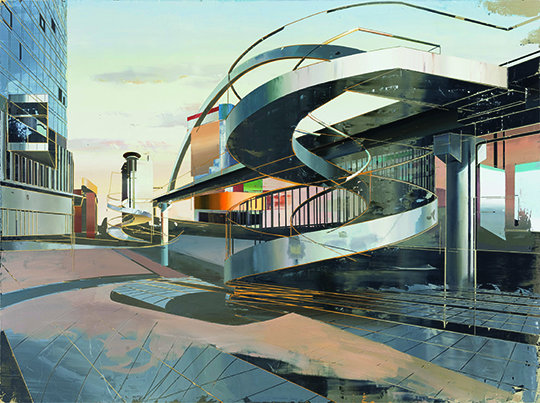THE PROPOSALS FOR OLD AND NEW URBANISM
| April 1, 2015 | Post In LEAP 31
LEO XU PROJECTS, SHANGHAI
2014.11.23~2015.01.04
Cui Jie’s solo exhibition “The Proposals for Old and New Urbanism” surveys paintings of urban architecture produced over the last two years, among which the figure of the overpass marks one of the major scenes. The right half of the new work Vision underneath the Overpass is filled with metal and the non-slip surfaces commonly seen on pedestrian overpass bridges, instantly evoking the physical memory of being suspended in transitional space. A background of blue sky and white clouds invades buildings in the foreground, while the transitional region between them resembles the residue left behind after peeling tape, a close encounter imposed by mutual destruction. Clearly, the buildings in the painting are depicted contrary to the traditional rules of perspective.

The painting Zhaowei Building is titled after a building in Jiuxianqiao, near Cui Jie’s studio on Jiangtai Road. Once again, the half-empty overpass appears. A glass-like portion of the overpass exposes buildings underneath, while a brown building in the background appears as if it were cut by a sharp knife and then shifted diagonally, introducing a form of impossible negative space apart from the city landscape depicted. Architect and composer Iannis Xenakis transforms parabolic forms into architectural planes and musical movements, while Cui takes reflective metallic shades and mediates the dislocation between landscape and object with directional light. In Overpass at Shuangjing, the artist erases parts of the overpass and replaces them with draftsman’s curves; the metallic texture and luster of ground, overpass, and glass curtain walls unify the tone of the painting.
If Cui Jie’s work expresses the marriage of architecture and painting, what matters most is her study of perspective. Before the appearance of CAD and rapid prototyping, Euclidean space was the foundational bedrock of architecture; traditional perspective is the fabricated net of Euclidean space, in which architecture and painting are eternally trapped. Based on the plane, translational lines rise into spaces of higher dimensions. Cui applies the techniques of transposition, cutting, overlapping, and deletion, thereby transforming the perspectival rays that restrain objects in homogeneous space into sharp edges that pierce through to heterogeneous space, where images and colors are kept intact and collide with one another, no longer submerged in the homogenous depth of field. Many painters attempt to get rid of the imaginary depth of field: David Joselit cites examples in his analysis of the history of painting, referring to the “reverse-depth” of collage, the horizontal extension of Jackson Pollock’s body movements, and the tautness of feeling proposed in Cubism—all provide a sense of psychological depth through planar visual effects, but these efforts are usually limited to using vertical and lateral movement to offset the imaginary coordinates of traditional perspective. With her subversion of perspective, Cui is not dizzy in Euclidean space, but rather adopts parallax as an effective weapon with which to crush space.
Pronounced architectural transformations can be witnessed in photography: from conception to completion (and perhaps demolition), a building continues to change because of geographical factors, policy, climate, and architectural whims. However, considering that the scientist Étienne-Jules Marey was able to freeze a flying bird into still images with a chronophotographic gun at 12 frames per second, the appearance of architecture is always relatively steady in Euclidean space. The physical properties of a building are essentially objective; the distance between subjectivity and objectivity results in the fossilization of the building. Cui Jie’s paintings disrupt this relationship as color blocks and objects overlap and invade one another’s space. Parallax, in her work, neither follows perspectival logic nor establishes a perception gap by juxtaposing different visual angles in a single assumed objective space. Visual disintegration provides a metaphor for the complexity of architectural history, but also exposes that architecture is a movement driven by physical, political, social, and historical vectors. Her imaginary, insurmountable sense of distance is like an overpass with two disconnected ends.
Venus Lau (Translated by Sheng Xia)

